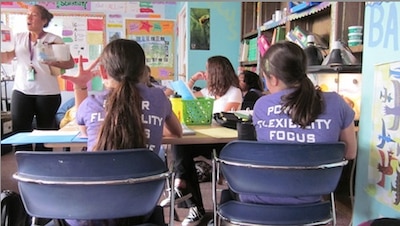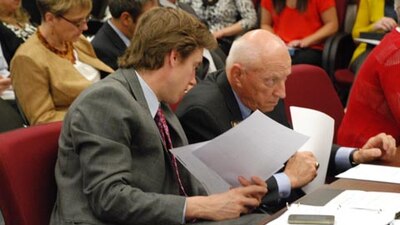The House couldn’t find time on a chaotic Friday night to pass the bill proposing a massive overhaul of Colorado’s school funding system.
The bill came to the floor shortly after 3 p.m. But progress got derailed by a big blowup over a surprise amendment concerning what to do with new revenue that would flow to the state after a tax increase is approved by voters but before the money is needed to implement Senate Bill 13-213.
If voters approve a tax increase this fall, additional revenue would start flowing in 2014, but SB 13-213’s new costs wouldn’t kick in until July 1, 2015.
Realizing that problem at the 11th hour, supporters had an amendment drafted, and bill sponsor Rep. Millie Hamner, D-Dillon, formally proposed it after the bill came up on the House floor. The change would have put the extra 18 months of revenue into school construction and broadband upgrades, among other uses.
The amendment was a surprise to everyone, from minority Republicans to education lobbyists. After a few minutes of heated rhetoric on the floor and frantic texting in the lobby. Hamner withdraw the amendment and went off to huddle with Sen. Mike Johnston, D-Denver, aides and other lawmakers.
A compromise was reached that proposes putting up to 40 percent of the revenue into a new education reserve fund, up to 40 percent into the Building Excellent Schools Today construction fund and smaller amounts into an educator effectiveness fund and an education technology fund.
But by then, SB 13-213 had lost its place in the big queue of bills on the House calendar. Members wrangled for hours over controversial energy conservation and marijuana bills. Hamner learned after 11 p.m. that SB 13-213 wouldn’t be brought back up.
The bill (and the amendment) now are on the calendar for Monday, the same day the House may hold preliminary debate on Senate Bill 13-260, the funding bill for the 2013-14 school year.
Once SB 13-213 clears the House it will return to the Senate for consideration of a long list of House amendments. However, there isn’t expected to be conflict over those changes, since the House changes were vetted ahead of time by the bill’s author, Sen. Mike Johnston, D-Denver.
While final legislative approval is nearing, that won’t be the last word for the bill. The bill requires a roughly $1 billion tax increase, which would have to be approved by voters.
Some of the bill’s supporters want a public vote this November, although it’s not certain that will happen. Coincidentally, the titles of 20 proposed ballot measures related to SB 13-213 were approved Friday by a state review board.
Kathleen Gebhardt, lead lawyer in the Lobato v. State school funding lawsuit, appeared before the review board Friday morning with appeals to several of the proposed measures. The review panel, known formally as the Title Board, granted her appeals only in relation to one small wording change. Gebhardt told EdNews her intervention in the matter “wasn’t a hostile maneuver by any means” but an attempt to clarify how the complicated funding mechanisms actually would work in some of the proposals submitted by the business group Colorado Forum.
Gebhardt, who represents three private citizens on the issue, said she doesn’t know if they will take the matter to the Colorado Supreme Court, as is allowed on the wording of ballot measures.
Long road for big bill
SB 13-213 started with a study process that began two years ago and involved hundreds of meetings and private conversations, most of them involving Johnston and his cosponsor, Sen. Rollie Heath, D-Boulder. But the bill’s progress through the legislature has been torturous.
Minority Republicans have consistently opposed the bill, saying it doesn’t contain enough education “reform” but really meaning that they oppose raising taxes.
Lobbying from a variety of education interest groups has forced a variety of significant changes in the bill. After all that work, few interest groups – ranging from charter schools to school districts to business groups – remain whole-hearted in their support, or in their opposition.
Inside a much-amended bill
Weighing in at 189 pages (at last count), SB 13-213 is as intricately balanced as a big Swiss clock, and just as complicated. (One part of the bill includes a quadratic equation.)
During prior House floor debate, prime sponsor Hamner admitted that maybe the only people who understand it are school district chief financial officers. One education lobbyist, watching from the gallery, grimly quipped that even the CFOs may not know all the bill’s intricacies.
That said, here’s an overview of the bill’s main features, as the bill stood following House amendments.
When it starts: The law would go into effect for the 2015-16 school year, but only if voters approve an income tax increase in November 2013. The new funding system wouldn’t go into effect until voters approve the necessary tax increase and would expire entirely if no election is held – or is successful – by November 2017.
What it costs: The full annual cost of the bill, including spending that would have to be approved by future legislature, is about $1.1 billion. The increase in basic K-12 operating costs, known as total program funding, is just under $900 million a year. Current spending is about $5.2 billion in state and district funds.
How enrollment is counted: The basis of any school funding system is enrollment. The new system would measure enrollment based on a method called average daily membership, which counts actual district enrollment throughout the school year. The current system is based on attendance counted during a narrow time window around Oct. 1 each year.
Early childhood education: A key feature of the bill is funding for full-day kindergarten for all students who want it. (Kindergarten attendance is not mandatory in Colorado.) The bill also would fund half-day preschool for all three-, four- and five-year olds who are eligible for the Colorado Preschool Program, which serves poor children and those who have other defined risk factors. More than 46,000 students are enrolled in full-day kindergarten, and another 20,500 attend half day. Current preschool enrollment is about 20,000; it’s estimated that more than 14,000 at-risk four-year-olds currently don’t participate.
At-risk students and English language learners: The bill puts significant additional resources into districts with the highest percentages of at-risk students and English language learners.
• All districts would receive 120 percent of the statewide per-pupil base for each at-risk and ELL student.
• Districts whose enrollment of those students exceeds the statewide average (which stands at about 42 percent) would receive funding for those students of up to 140 percent of the statewide average.
• Students who are both at-risk and ELL will receive double funding for up to five years.
• The definition of at-risk is expanded to include students eligible for reduced-price lunch (about 60,000 students now). That’s on top of the approximately 289,000 students eligible for free lunch.
• A group of 15 districts would receive “supplemental” at-risk funding (about $274 per pupil in most cases). Those districts include Jefferson County, St. Vrain, Mesa Valley, Thompson, Brighton, Widefield and Pueblo 70, plus some smaller districts. Those districts felt they were slighted by the bill’s original provisions, and this amendment was added in the House. Another group of more than 80 districts are in a similar situation but wouldn’t receive additional funding.
Other adjustments for individual districts: The current system adjusts many districts’ funding based on size. Under the new system only districts with fewer than 4,023 students will receive additional funding for size. Another current “factor” provides extra money to many districts based on the cost of living for staff. That’s eliminated by SB 13-213. Some larger, primarily suburban districts with lower concentrations of poor students felt they were unfairly treated in the original version of the bill. In response to pressure, an amendment created “floor” funding for 31 districts equal to 95 of statewide average per-pupil funding. Additional, more technical safeguards also were built in for those districts.
Additional per-pupil funding: Under part of the bill called Teaching and Leadership Investment, every district would receive an additional $441 per pupil. This money is generally intended to help districts with the costs of implementing new content standards and tests, the new teacher evaluation system and other recently state-imposed reforms. The proposed amount was originally $600 a student, but that figure was cut to shift money to pay for other amendments to the bill. The amount gradually would rise to $600 depending on increases in revenue from the new taxes. The amount could go down if revenues from the new taxes decline.

Charter funding: This was a sore point as the bill moved through the legislature, with charters unsuccessfully lobbying for a requirement that local tax overrides be shared pro-rata with charters, something the school districts opposed. As it stands, the bill includes an override-sharing negotiations process between districts and charters. Charters that don’t like the way that turned out could switch their oversight to the state Charter School institute. The bill contains $18 million to partially compensate charters for facilities costs and creates a tiered system for allocating that money. The measure also would increase at-risk and ELL funding for charters and provide other increases for institute-supervised schools.
“Backpack” funding: Another hotly contested issue was how much autonomy principals would have in spending of at-risk and ELL funding provided by the state. Some education reform groups favor wide school-level autonomy, sometimes know as “backpack funding” or “money following the student.” The Colorado Association of School Boards opposed the bill’s original provisions as infringing on the constitutional powers of school boards. A compromise amendment adopted in the House gives district superintendents and boards oversight over principals’ spending plans.
Special education: The bill includes $80 million additional funding for what’s called Tier B special education support and would allocate additional funding as revenues from the next taxes increase over time. Tier B is for severely disabled students.
Innovation grant fund: The bill also proposes a $100 million fund that could be distributed to districts that apply for various education reforms. The bill originally envisioned most of that money being used for extended school days and years. But amendments added during the legislative debates have added other permissible uses, such as student retention. The grants would be administered by a new board appointed by the governor.
District tax increases: The bill would raise current ceilings on the amount of local tax increases, known as mill levy overrides, that districts can seek from voters. It also would permit new kinds of earmarked local tax increases, including for early childhood education, technology purchases and building maintenance and staff cost of living.
The bill also includes a calculation intended to determine which districts are raising less in local taxes than their property wealth would indicate. But amendments ensure that those districts wouldn’t ever be penalized and includes a “hold harmless” provision affecting 25 districts.
SB 13-213 also contains a provision for state matching funds to districts with low property values.

Accountability: Johnston likes to point out that the bill would provide an unprecedented amount of “transparency” about school and district spending. The bill requires periodic reports on both adequacy – whether schools are receiving enough money – and return on investment – whether the increased K-12 spending in yielding improved student achievement.
Miscellaneous provisions: The bill also includes additional, if relatively small, amounts of additional funding for teacher career development, gifted and talented students and for facilities schools, which serve students in detention and residential treatment.
